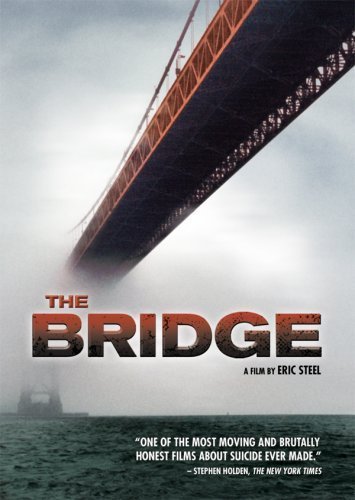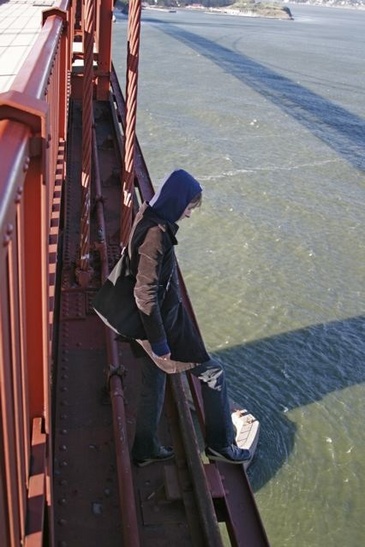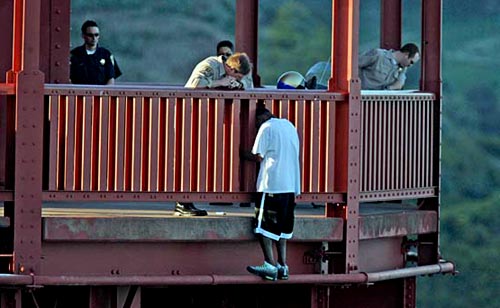Tag: death
-
The Photos of Anders Behring Breivik
Tags: andersbehringbreivik, associatedpress, cnn, crime, death, facebook, gettyimages, intellectualproperty, oslo, reuters
This post is not about what Anders Behring Breivik (allegedly) did. Instead it’s about the photos.
Everywhere you look, you see professional portraits of the suspect. Where did these images come from? Obviously, they came from the Anders Breivik, but where did the media get them? What was the context that they were taken in?
I found the proximal answer to where the media got them. Most photos of the man on CNN are attributed to Getty Images, but where did Getty get them? I didn’t know, until I read the attribution on the above picture from CNN. “Facebook via Getty Images.” [Original Link]
Wait. “Facebook via Getty Images?” What does that mean? How does Getty get the attribution? Do they own the right to license the images to news agencies or what? Did Facebook just invoke their right to sub-license (See section 2.1 of Facebook’s Terms and Conditions) Anders Behring Breivik’s photos to Getty for (blood) money?
Inquiring minds want to know.
Update: Mon Jul 25 01:28:50 PDT 2011
Let me be clear. It’s not not just Facebook and Getty. There’s this photo that carries a Reuter’s copyright notice no less. This photo appears again, this time with “AP Photo / Twitter” attribution. And again, but with Getty. Either Getty, AP, and Reuters are engaging in widespread unauthorized redistribution of copyrighted materials for commercial gain, someone (meaning Facebook and possibly Twitter) has sublicensed the photos, or the AP, Reuters, and Getty are making a very dubious fair use claim over distributing the photos.
(more…) -
GGB Jumper Survives

A 17 year old high school student survived the 220 foot jump with a broken tailbone and a torn lung.
He did it on a dare.
-
The Bridge

I finally watched Eric Steel’s film The Bridge on Hulu. After reading this 2003 New Yorker article about Golden Gate Bridge suicide jumpers, Eric Steel set up cameras around the GGB to film the jumpers. He managed to film 23 of the 24 suicides in 2004, and in the process, annoy CalTrans for showing a part of the bridge experience that tourists shouldn’t see.
The film is fascinating, and thankfully doesn’t take the easy melodramatic or Helen Lovejoy approach. Steel treats the the subject, and everyone, involved with a distance that makes the film come off as more descriptive than anything. Other film makers may have turned the second half into a call for foxconn-esque nets.
When I first mentioned bridge jumpers, I said:
I [had become] enamored with the moment that the jumper’s center of gravity moves over the water, and the inevitable plunge begins. That moment, when your heart skips a beat, and your stomach tenses, and you think “Here we go!†It’s not the moment of total commitment. No, it’s the moment just after that. Did they intend to go just then, or were they just trying to get up the nerve when they slipped? More disturbingly, do they change their mind on the way down?
In the film, jump survivor Kevin Hines, recounts his experience. “[I] hurdled over the railing with my hands, and I was falling head first. And the second my hands left the bar – the railing – I said, ‘I don’t want to die. What am I going to do? This is it. I’m dead.’” Watching person, after person, simply turn, climb over the railing and immediately jump, I wonder how many of them were like him.
One that probably didn’t think twice was featured jumper Eugene Sprague. The interviews with Sprague’s friends, reveal a man that for years had decided to kill himself. He simply was waiting for the time to do it. He reminded me of my great aunt Doris. Aunt Doris, talked about suicide for years. She even tried a multiple times, while simultaneously teaching me lessons about suicide. Lessons like, cutting your wrists doesn’t work. You have to cut your elbows, or as they say, “Down the road, not across the street.” She taught me, that if you want to get hit by a train, you should check the train schedule first. Perhaps her best advice was when she told a 9 year old me, “Jonathan, if you ever want kill yourself, don’t try to electrocute yourself. It hurts like hell.” My response: “Oh, okay.” My mom and my great Uncle Lee, would take her to psychiatrists for years, but none of that helped. My mom says that eventually one of them simply said, that Aunt Doris would keep trying until eventually she succeeded.
On my birthday, (I think my 10th birthday), she came over and brought me a lava lamp, almost identical to the one that she had sitting in her living room. I thought her lava lamp was one of the coolest things around. When I opened the box, I was amazed. I couldn’t imagine ever getting something so grown up like a lamp. It was awesome. She said, sitting in the recliner of my parents’ living room. “I got you that so you’d have something to remember your crazy Aunt Doris by.” I was confused by the statement, but mostly just in awe of owning a lava lamp. I remember that my mom got up and left the room rather angrily, and I had no idea why. The next day, Aunt Doris shot herself in the heart with a pistol and died.
I still have the lamp.
-
Simian Armed Liberation Front
Categories: other
China Daily reports:
Afghanistan’s Taliban insurgents are training monkeys to use weapons to attack American troops, according to a recent report by a British-based media agency.
Reporters from the media agency spotted and took photos of a few “monkey soldiers” holding AK-47 rifles and Bren light machine guns in the Waziristan tribal region near the border between Pakistan and Afghanistan. The report and photos have been widely spread by media agencies and Web sites across the world.
Well there there is precedence for monkey armies, along with tales of their legendary ferociousness. AND DON’T YOU DARE SAY THAT MONKEY ARMIES ARE A MYTH!
-
Execution Ribbons

Being a child of the Cold War, I was fascinated with military; both with the weapons and the uniforms. My World Book encyclopedias would fall open to the insignia entries for the Air Force, Army, Navy, and Marines. My interest in medals and insignia continues to this day. I can literally spend hours browsing the Army Institute of Heraldry, or Starfleet uniforms, or Imperial rank insignias.
I was bit surprised (and taken back) by the fact that the Utah Department of Corrections issue ribbons to prison guards that participate in executions. Well, more accurately, the did, now they issue commemorative coins, just like the Super Bowl. (“The staff preferred something a little more modern than the ribbons.”)
Apparently the guards “awarded” these ribbons didn’t actually wear them. I’m thinking more out of fear of retribution rather than decorum. The ribbons weren’t issued to only the firing squad, but to anyone involved. Perhaps it’s my opposition to the death penalty talking, but I find these medals morbid. While the military awards combat ribbons, many of the actions that they’re awarded for involve rescuing someone, or at least holding out against an enemy. It’s rarely for just killing. Even if it was, at least the people being killed at least are fighting back. Shooting a man that’s tied to a chair, is just state sanctioned murder.
Even as I’m repulsed by the notion of these ribbons, I stare at them and try and deduce a schema for them. Do slants represent executions? Do diamonds represent escapes? Does squares represent administrative tasks? Its frustrating not to know. I wish the picture showed them all. I even want one for some macabre reason, just to put on a shelf, or even a Wunderkammer.
-
Bridge Jumpers in 2009

It’s that time of year again, where we (and by “we,” I mean “The Marin County Coroner’s Office”) tally up the number of jumpers from the World’s Leading Suicide Magnet, YOUR GOLDEN GATE BRIDGE!
A drumroll please….
If you chose 31, congratulations! You win a year’s supply of Rice-a-Roni – The San Francisco Treat *ding* ding*. Yes, 31 successfully took the plunge in 2009 (That’s one every 11 days!), and another 77 managed to screw it up (like everything else in their miserable lives) and got stopped by staff. (Another year without a local Lai Jiansheng “helping” anyone.)
So what about the $50 million net that was approved back in aught-eight? Well, that’s still in limbo, since the Bridge District has forbid local money to be used for the nets, and now the Bridge Rail Foundation is trying to get federal funds.
Is 31 a lot? The Pro-Net folks would no doubt saying something vacuous like “Even a single jumper is one too many,” but let’s look the numbers. 31 is 72% more than then average since the bridge opened in 1937, but is that number really meaningful? The Bay Area’s population has been steadily increasing, so what about the “success” rate? There are over 7 million people in the Bay Area today. In 1940 there was less than 2 million. Perhaps if we want more informative numbers, we should look at this instead in terms of suicides per capita.
Unfortunately, I don’t have the number of jumpers per decade, but
the SF Examiner, provided a helpful table of the number of jumpers over the last eight years, that show that every year was “above average.”UPDATE: Tue Jan 26 00:23:45 PST 2010
I realized that I did have the number of “splash hits” each year that the bridge opened, thanks to the Chron. The Chron’s count differs slightly from the Examiner’s, but not enough to matter. (The Chron counts one more in both 2002 and 2004.) Coupling this with Bay Area population stats, I calculated the GGB Suicides Per Capita.While I haven’t bothered to do any sort of significance testing, it appears that for the last 30 years, the number of successful suicides has remained constant after controlling for population. In fact, it appears pretty much constant for 4 of the last 5 decades. So just as I suspected, the “above average” statement is a bit misleading.
If anyone wants to look at the numbers, I’m posting a CSV of the numbers.
-
Your Typical Jumper

I’ve posted about my morbid fascination before, but today the Chron wrote about the demographics of a jumper. (Well actually, it’s just a press release from The Bridge Rail Foundation dressed up as news, but it’s fascinating none the less.)
The report, examines 15 years of jumpers, and answers some of my long standing questions about jumpers.
- How many people travel from outside the Bay Area simply to jump?
- 83% are from the bay area, with just under half (49%) coming from Marin, Napa, San Francisco, and Sonoma counties. 6% come from outside of California, and only 3 (less than 1%) came from outside the US.
Follow Up Question: How does the 6% outside of the state compare with other popular suicide sites? Is the bridge truly a “suicide magnet?”
- What does the typical jumper look like?
- White (80%), Male (74%), Never Married (56%), 40 year old student.
In case you’re wondering: I’m against the rail and the nets. I think it will just move them behind closed doors and away from the tourists. Plus, there’s something romantic, and yet simultaneously incredibly selfish, about doing it in public.

